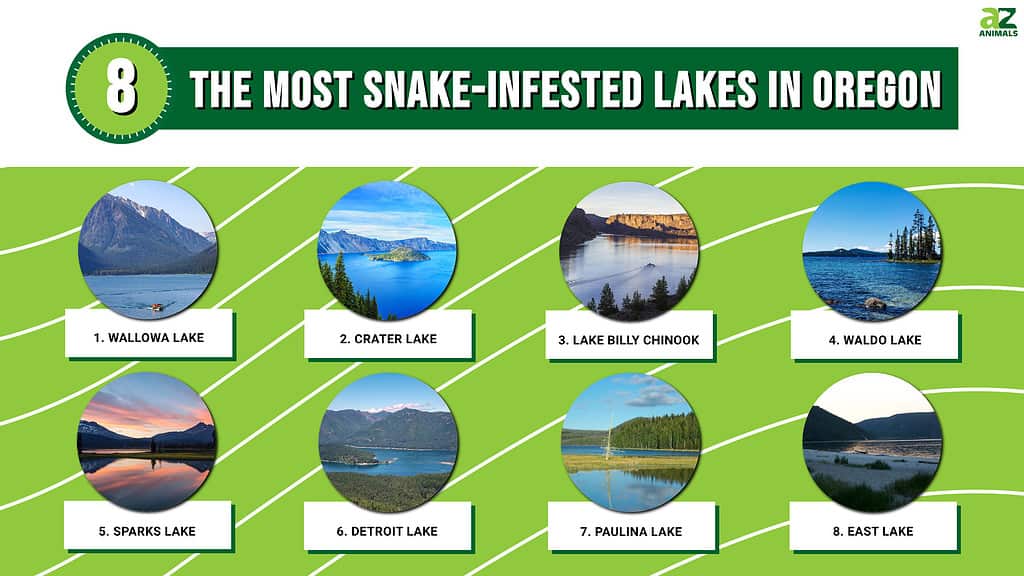
Oregon’s Native Snakes
As mentioned above in the key points, Oregon is only home to 15 native snake species. These include four species of garter snakes: the common garter snake (Thamnophis sirtalis), the northwestern garter snake (Thamnophis ordinoides), the western terrestrial garter snake (Thamnophis elegans), and the Pacific coast aquatic garter snake (Thamnophis atratus). Oregon is also home to the gopher snake (Pituophis catenifer), the night snake (Hypsiglena chlorophaea), the racer (Coluber constrictor), the striped whipsnake (Coluber taeniatus), the sharp-tailed snake (Contia tenuis), the ring-necked snake (Diadophis punctatus), the ground snake (Sonora semiannulata), the California mountain kingsnake (Lampropeltis zonata), the common kingsnake (Lampropeltis getula), and the rubber boa (Charina bottae). None of these have venom that is harmful to humans. The only venomous snake that lives natively in Oregon is the western rattlesnake (Crotalus viridis).
Of these 15 native snake species in Oregon, several are sadly in danger of extinction. The western rattlesnake, common kingsnake, are California mountain kingsnake are all considered of sensitive conservation status. The western rattlesnake in particular is considered in critical danger. In addition, the sharp-tailed snake and western ground snake are protected species.
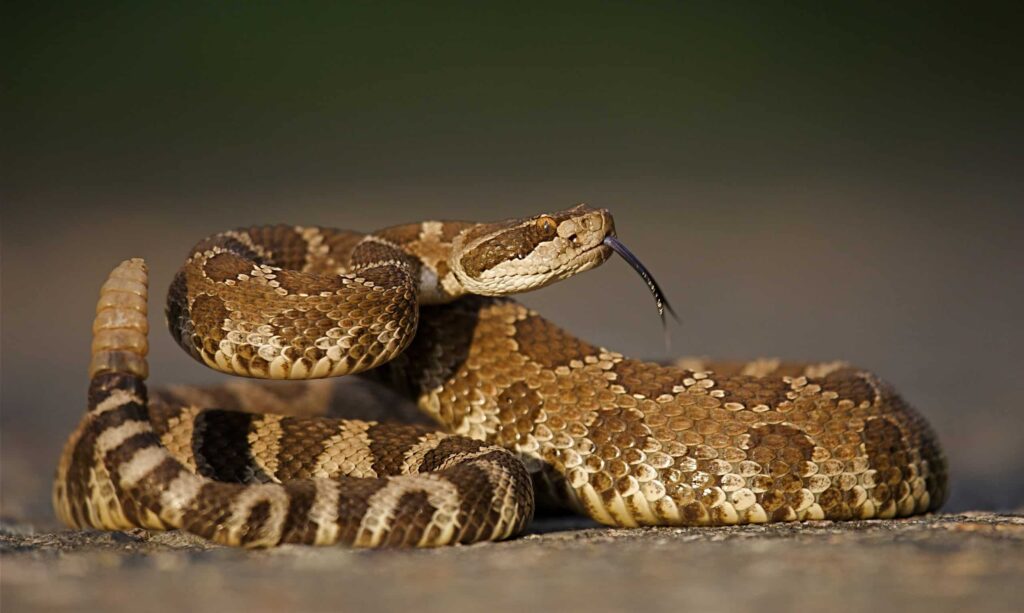
Oregon’s only native venomous snake species is the western rattlesnake.
©Tom Reichner/Shutterstock.com
Water Snakes in Oregon
Oregon does not have any true water snakes inhabiting its lakes and rivers. North America’s true water snake species all belong to the genus Nerodia. Nerodia includes nine different species which are native to North America. These snakes live near water sources and spend the majority of their time in wetland habitats. However, none of these inhabit Oregon.
Although Oregon does not have any true water snake species, there are two species of semi-aquatic species of snakes that you might find while exploring Oregon’s waterways. A semi-aquatic snake spends most of its time on land, but can also frequently be found living near or in water. The best environments for semi-aquatic snakes are moist, vegetative areas such as marshes, swamps, and lakes.
These two semi-aquatic snakes that live in Oregon are the Pacific Coast aquatic garter snake (Thamnophis atratus) and the western terrestrial garter snake (Thamnophis elegans). Neither of these are venomous. However, if you are exploring meadows, marshy areas, or the riverbanks near streams and lakes, you may encounter both of these snake species. These snakes are not considered venomous or dangerous to humans. However, both species of snake may become aggressive if they are startled or feel threatened. Since they have mouths full of sharp, tiny teeth, a bite could hurt and result in irritation. Because of this, it is best to watch these snakes from a distance and otherwise leave it alone.
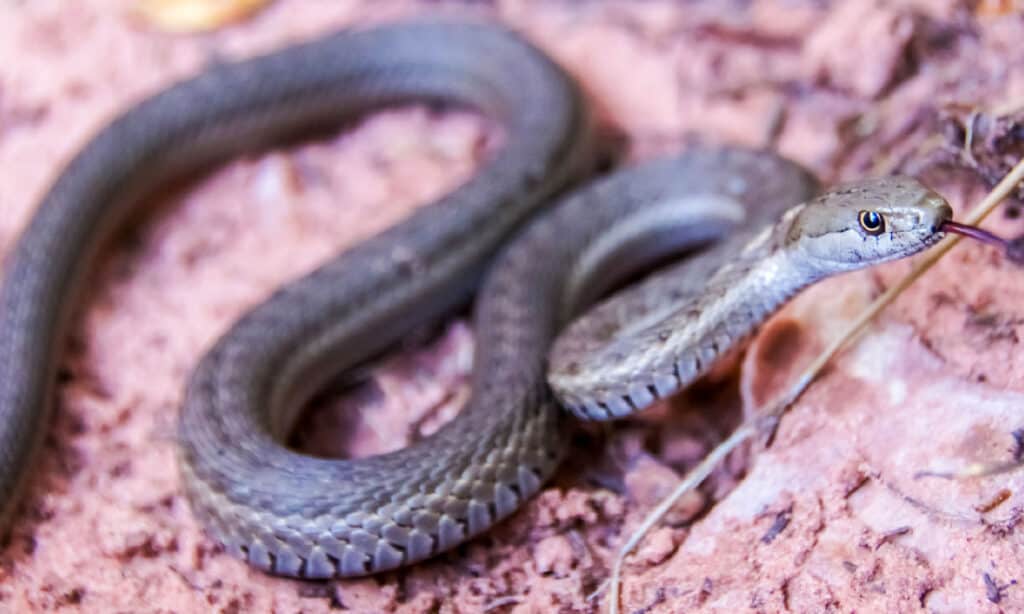
Nearly all western terrestrial garter snakes have three stripes down the length of their bodies — a dorsal stripe and one stripe on either side, just above the belly.
©iStock.com/yhelfman
Pacific Coast Aquatic Garter Snake (Thamnophis atratus)
The Pacific Coast aquatic garter snake lives primarily around rivers in the southwestern part of Oregon. As one of four garter snakes that live in Oregon, the Pacific Coast aquatic garter snake is a non-venomous species that is recognizable by its distinctive scale pattern. These snakes have brown or gray bodies with three longitudinal yellow stripes running down their bodies. These stripes may be bright or pale yellow and may have a checkered or barred pattern. The typical Pacific Coast aquatic garter snake typically grows to be between 18 and 33 inches long.
These snakes eat diets consisting of small fish or minnows, salamanders, tadpoles, frogs, toads, worms, leeches, and salamanders that share their wetland habitat. These snakes often appear in Oregon’s meadows, marshes, and forests, and near rivers, lakes, and ponds. They navigate these waterways very well and are excellent swimmers. On a sunny day, you may see these garter snakes soaking up the sun on rocks and logs. If a predator comes along and threatens them, these strong swimmers will slither into the water to seek safety.
Western Terrestrial Garter Snake (Thamnophis elegans)
There are three subspecies of western terrestrial garter snakes that live in Oregon. Though these snakes live throughout the state, they tend to stay away from the northernmost parts of Oregon. The three subspecies include the coast garter snake and mountain garter snake, both of which primarily live in Oregon’s southwestern region. The third is the wandering garter snake, which lives east of Oregon’s Cascade Mountains.
These snakes have brown, gray, or black bodies, with checkered patterns between yellow stripes. The snake typically grows to be between 18 and 43 inches long.
These snakes typically consume small fish or minnows, frogs, tadpoles, worms, or salamanders. These snakes live near slow-moving bodies of water, such as streams and ponds. They often appear during the day in moist wetland areas such as meadows and marshes. If a predator comes along and threatens them, these snakes hide in holes in the ground or rocky crevices.
Snake-Infested Lakes in Oregon
1. Wallowa Lake
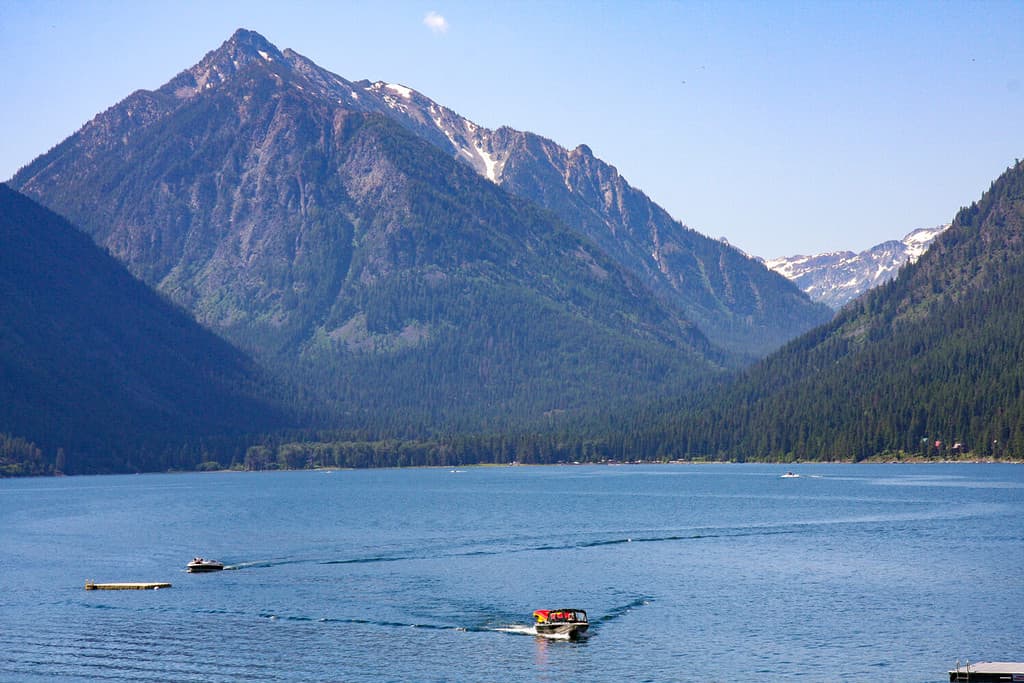
Wallowa Lake is located near Joseph, Oregon.
©CSNafzger/Shutterstock.com
Wallowa Lake in Wallowa Lake State Park is a scenic glacial lake situated between the tall Wallowa Mountains. This ribbon lake sits about one mile south of Joseph, Oregon. The small community has plenty of homes, vacation lodging, restaurants, and independently-owned businesses. This lake is fed by the Wallowa River, and both the lake and the river provide plenty of opportunities for picnicking, hiking, boating, and camping.
Wallowa Lake has also gained a reputation for having diverse wildlife species near its waters. Visitors regularly spot Oregon’s only venomous snake, the western rattlesnake, on the land near the water’s edge and surrounding area. This lake in eastern Oregon provides a fantastic habitat for western rattlesnakes and other non-venomous snake species to live and eat the small mammals, amphibians, and fish that share the environment. However, do not let that keep you away from enjoying all of the natural beauty and outdoor recreation that Wallowa Lake has to offer! You might even get lucky and get to spot some of the other wildlife species living near Wallowa Lake. These include deer, squirrels, bighorn sheep, cougars, elk, black bears, and even wolverines, in addition to many different bird species.
2. Crater Lake
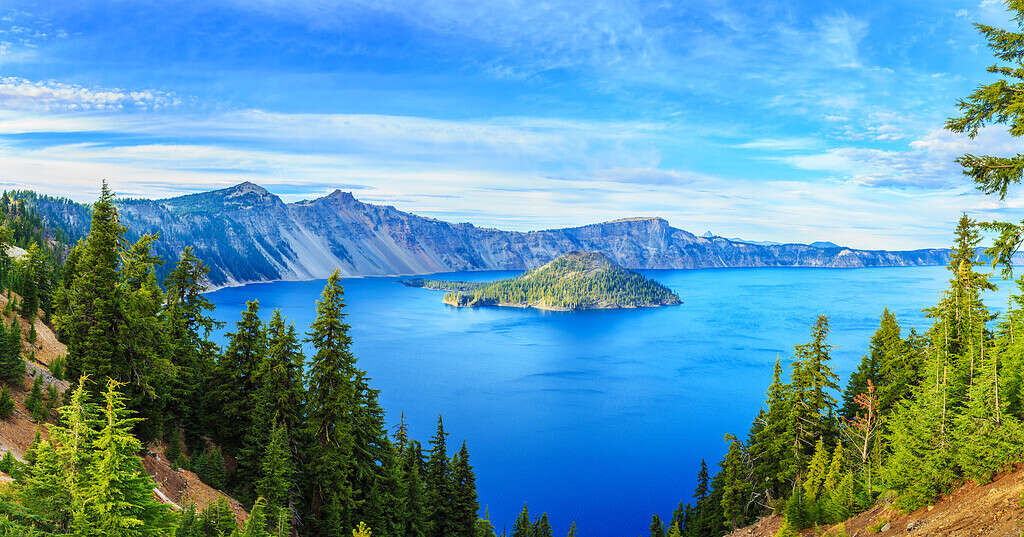
This serene view of Crater Lake is a reminder of the power and beauty of nature.
©iStock.com/Photographer and videographer from Ukraine
Crater Lake in Craker Lake National Park is the deepest lake in the United States and the seventh deepest lake in the world. At 1,943 feet deep, this deep volcanic crater lake is famous for having a striking blue color. Its waters fill a volcanic basin of a sleeping volcano. Each year, the lake’s waters are replenished by melting snow, making its waters appear crystal clear. The stunning views and opportunities to hike and enjoy the lake’s nearby land attract thousands of visitors each year.
The gorgeous Crater Lake is home to 19 reptile species that are native to the land inside the park’s borders. This includes three species of garter snakes spotted inside the park. These snakes typically are not dangerous for humans and only eat insects, amphibians, and sometimes small mammals or birds when given the chance.
3. Lake Billy Chinook
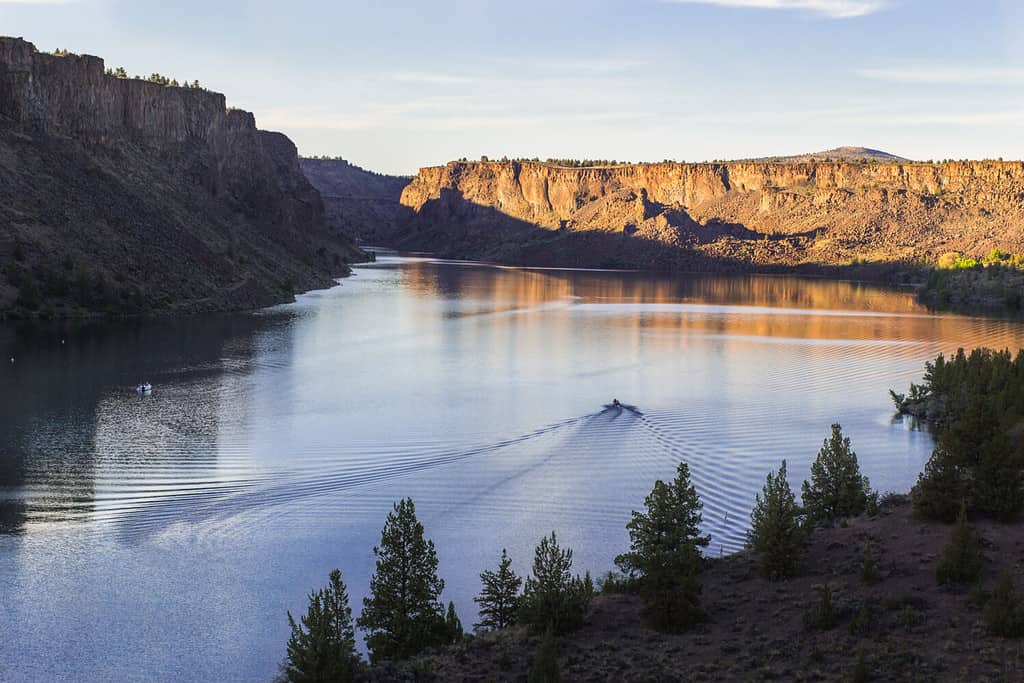
Lake Billy Chinook is a water reservoir in Oregon.
©Victoria Ditkovsky/Shutterstock.com
One of the most popular getaways in Oregon is Lake Billy Chinook, a water reservoir in central Oregon. Lake Billy Chinook was created by Round Butte Dam, which fills the canyon areas of the Crooked River, Metollius River, and Deschutes River. The resulting reservoir is a popular destination for boating, fishing, water skiing, and other water sports. The reservoir is only about a 45-minute drive outside of Bend, Oregon, and has 72 miles of shoreline for visitors to enjoy.
Lake Billy Chinook is also home to many different snake species – including many non-venomous gopher snakes, which are often mistaken for the venomous western rattlesnake. Western rattlesnakes also inhabit the land around Lake Billy Chinook. Sadly, the number of visitors to the reservoir and the common misconceptions about snakes lead to many rattlesnakes and gopher snakes (which are often mistaken for rattlers) being killed each year.
4. Waldo Lake
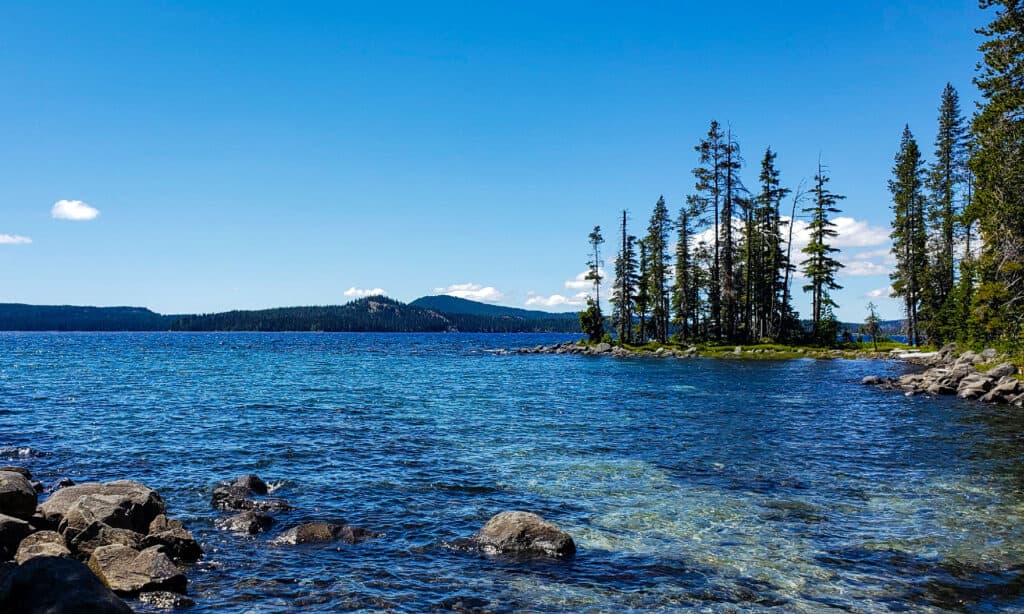
Waldo Lake is a 6,700-acre alpine lake in the Cascade Mountains of Oregon.
©Amy Bradley MNR/Shutterstock.com
On the western slopes of Oregon’s Cascade Mountains lies the Waldo Lake Wilderness Area in Willamette National Forest. This lake was formed by ancient glaciers. Today, it covers 10 square miles and has crystal-clear water. On a clear day, you might be able to see as deep as 100 feet below the lake’s surface! In the Waldo Lake Wilderness nature preserve area, visitors can hike about 84 miles of trails. Many of these take hikers beside lakes, meadows, and other unique habitats. The park provides ample opportunities for hiking, camping, mountain biking, swimming, and boating. However, as you traverse trails with rocky areas full of nooks and crannies, watch out for the native snakes living in the area!
Waldo Lake Wilderness Area visitors may notice some of Oregon’s native snake species, including the common garter snake, the northern rubber boa, sharp-tail snakes, and other non-venomous snakes.
5. Sparks Lake

Sparks Lake is a natural lake in Oregon.
©Sandra Woods/Shutterstock.com
Sparks Lake, in Deschutes National Forest, sits about 25 miles west of Bend, Oregon. The lake gained its name in honor of “Lige” Sparks, who was a pioneer stockman in central Oregon. Unlike some of the other lake reservoirs on this list, Sparks Lake is a natural lake near the crest of Oregon’s central Cascade Mountains. This 400-acre lake only reaches depths of about 10 feet. Surrounding the lake is 370 acres of beautiful wetland habitat. Visitors come to the area looking to go fly-fishing, kayaking and canoeing, hiking, and sightseeing.
Near Sparks Lake, visitors may notice that garter snake species and gopher snakes make frequent appearances in the marshy areas. These snakes feed on the plentiful amphibians that also make the area their home. Look for Pacific giant salamanders, rough-skinned newts, toads, and frogs. You should also watch out for the diverse birds that nest in the area. These include golden eagles, woodpeckers, California gulls, red-tailed hawks, night hawks, and many others.
6. Detroit Lake
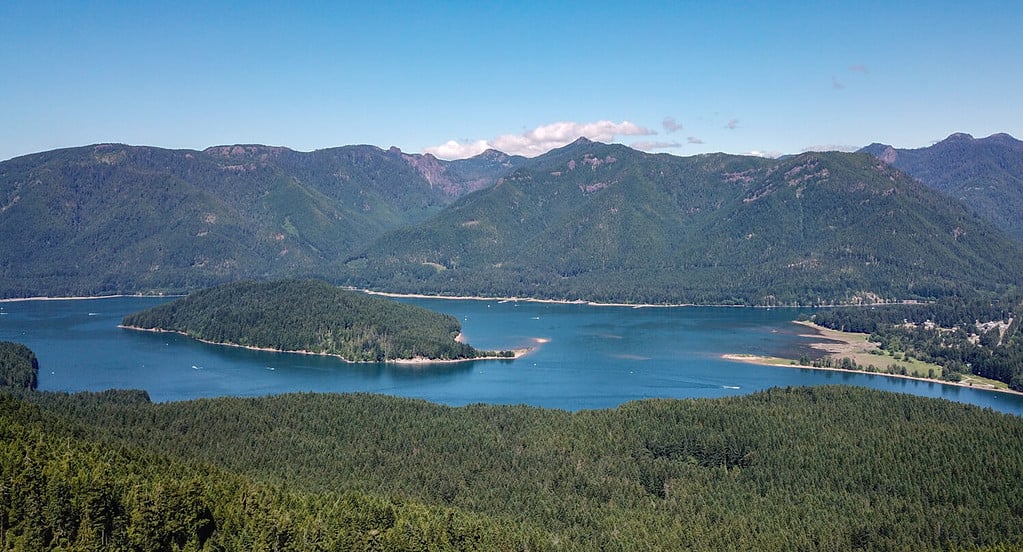
Detroit Lake is part of Willamette National Forest in Oregon.
©Tyler Gray/Shutterstock.com
Not to be confused with the city in Michigan, Detroit, Oregon was named after its midwestern counterpart in the 1890s. Near Detroit, Oregon, and just 46 miles south of Salem, Oregon, sits Detroit Lake. This reservoir, created by the Detroit Dam, provides water to the surrounding communities. However, this nine-mile lake is also a popular destination for visitors looking to enjoy fishing, boating, and the gorgeous sights of the nearby snow-capped Mt. Jefferson. Like Waldo Lake, Detroit Lake is part of the Willamette National Forest.
While hiking the area around Detroit Lake, you may see local wildlife such as willow flycatchers, rufous hummingbirds, golden-mantled ground squirrels, various warblers, salamanders, and various garter snakes. Though Detroit and Detroit Lake have recently suffered through burning from wildfires, which destroyed plants and over 5,000 buildings and homes in area Detroit area, the resilient people and wildlife are working hard to recover and regain its tourism industry.
7. Paulina Lake

Paulina Lake is one of two lakes in the Newberry Crater.
©Neptunerover / CC BY-SA – License
25 miles outside of Bend, also in Deschutes National Forest, Paulina Lake lies within the caldera of Newberry Volcano. This is one of two crater lakes in the Newberry Volcano Crater, alongside East Lake. These twin lakes originated from the volcanic eruptions that formed the caldera over 500,000 years ago. They receive their water from snow, rain, and hot springs. Both are also major attractions for visitors who come to the nearby resorts, many cabins, and campsites. Each year, visitors go boating, fishing, and hiking in the area. These two high desert country lakes also have numerous fish species living in their waters, making game fishing a popular activity for anglers seeking to catch large and smallmouth bass, trout, and other fish.
8. East Lake
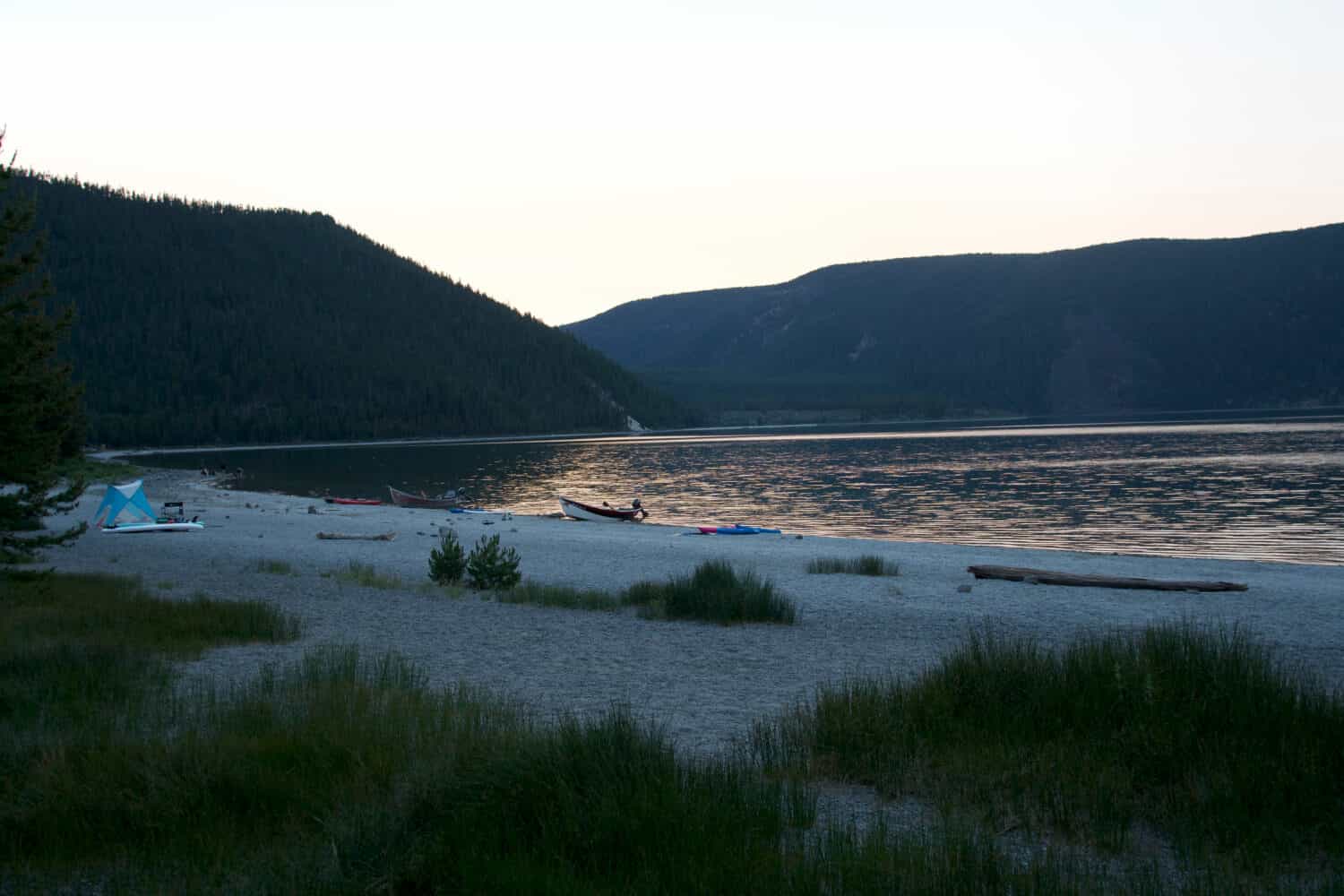
East Lake is home to gopher snakes and garter snakes.
Image: Jared Abell, Shutterstock
©Jared Abell/Shutterstock.com
Paulina Lake and East Lake are part of a natural area full of many different animals, including cougars, bears, and the venomous western rattlesnake. However, you can also look out for gopher snakes, common garter snakes, racers, rubber boas, whip snakes, and others. Although this is not a common appearance, some report seeing northern Pacific rattlesnakes coming into the area in addition to the venomous western rattlesnake.
Safety and Preventing Problems
To stay safe while hiking and enjoying Oregon’s outdoors through other activities, follow a few key guidelines. First, you can avoid an unexpected encounter with a snake by staying on well-used, open trails with good visibility. In general, it is a good idea to avoid walking through thick brush. However, if you are hiking through brushy areas, use a walking stick that can help to alert a snake that you are approaching. Do not step in places where you cannot see the ground or place your hands in places where you cannot see.
Second, wear long, loose-fitting pants and boots that cover your ankles. This can help to prevent a snake bite.
Third, if you do see a rattlesnake, keep an eye on the snake from a distance. If you run across one on a trail or in the brush, quickly move away. The snake wants to avoid you as much as you want to avoid it! As you move away, watch out for defensive behaviors that let you know you are getting too close and the snake feels threatened – behaviors such as a defensive coil, shaking the rattle, or moving to strike.
Regardless of the snake species you encounter, a snake bite can lead to irritation or infection. While non-venomous snakebites are typically harmless, some people may be allergic and a bite can cause skin irritation. If you get bitten, clean and sterilize the bitten area and immediately consult a doctor.
Importance of Snakes
Remember, snakes of all types play an important role in the ecosystem! Even venomous snakes have a function in maintaining the balance of their habitat. Not only do snakes help to maintain the biodiversity of the earth by regulating the populations of animals that they prey upon, but they also serve as prey for other animals. This helps to maintain the delicate balance of a world in which all species are interconnected and have a vital part in keeping diverse plant and animal species alive.
Summary of the Most Snake-Infested Lakes in Oregon
| Oregon Lake | Snakes | |
|---|---|---|
| 1 | Wallowa Lake | Western rattlesnake |
| 2 | Crater Lake | Garter snakes |
| 3 | Lake Billy Chinook | Rattlesnakes, gopher snakes |
| 4 | Waldo Lake | Common garter snakes, northern rubber boas, sharp-tail snakes |
| 5 | Sparks Lake | Garter snakes and gopher snakes |
| 6 | Detroit Lake | Common Kingsnakes |
| 7 | Paulina Lake | Gopher snakes, common garter snakes, racers, rubber boas, whip snakes, rattlesnakes |
| 8 | East Lake | Gopher snakes, common garter snakes, racers, rubber boas, whip snakes, rattlesnakes |
The photo featured at the top of this post is © steve estvanik/Shutterstock.com
Thank you for reading! Have some feedback for us? Contact the AZ Animals editorial team.







